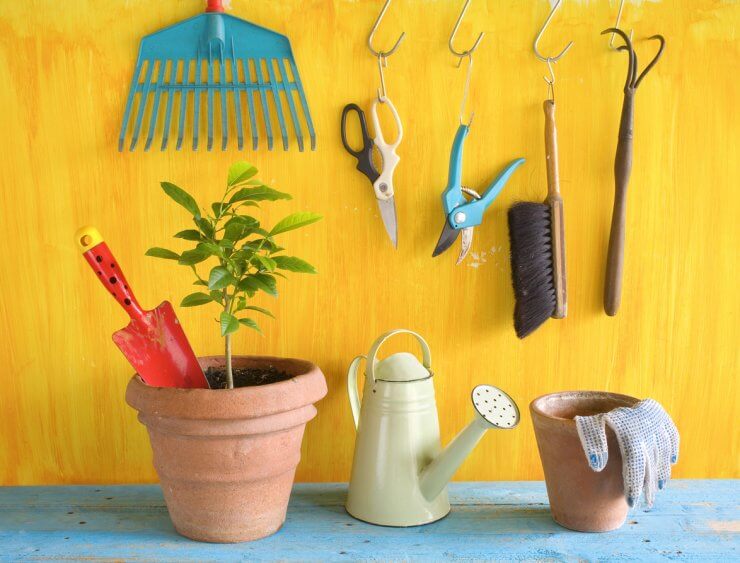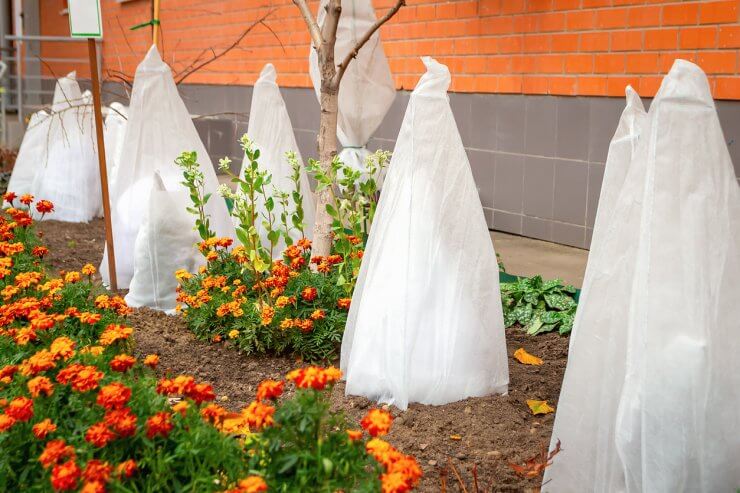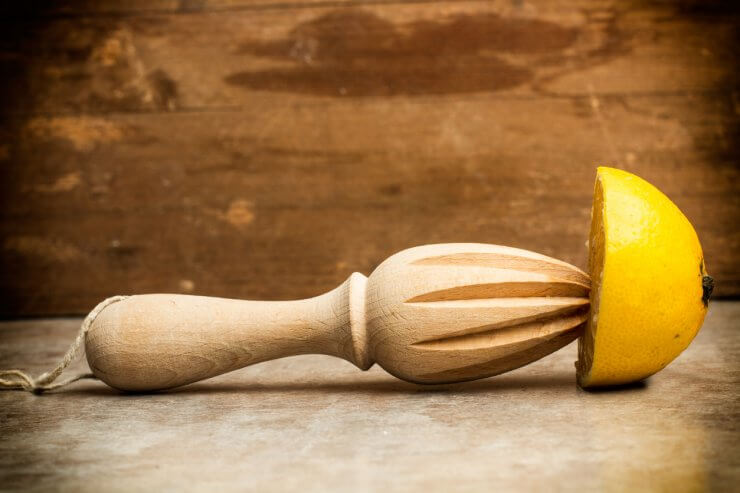
Essential tools for gardening lemons
Tending your lemon tree or cooking with lemons means having the right tools to do the job in both the garden and the kitchen.
Below is a list of items to consider. If you don’t already have some of these items, please check our Resources about Lemons for recommended suppliers for acquiring the right tools and equipment.
Lemon-specific tools and equipment:
CloudCover: This is a spray that forms a gas-permeable film on your tree’s leaves. It protects them from water loss, but still allows the plant to breathe. The manufacturer says it goes on clear with no residue and leaves the plant’s leaves clean and shiny.

Frost cloth
Frost Cloth: Frost cloths are made with tiny holes that allow water in while still retaining heat to protect your trees from frost. Be sure to secure your frost cloths all the way to ground level so no cold air seeps in from the bottom.
Fruit Tree Watering Kit: This kit is a type of drip irrigation system that cuts the time it takes to water your tree. If you have more than one tree, this can be a real time saver. This works with trees planted in open land as well as container trees on your deck or patio.
Loppers: As your lemon tree grows, so will the branches. There will come a time when pruning shears just won’t cut it. Get yourself a sturdy pair of loppers.
Lemon Juice Sprayer: Give your salad or veggies a little spritz of lemon with this cute little gadget. It’s like a reamer with a spray head on top. Just twist it into your lemon, give a little squeeze, and spritz away.
Lemon Press/Juicer: When your tree produces lemons, you’ll want to be able to easily extract that delicious juice! Invest in a lemon press (it looks a lot like a garlic press) or a juicer in the old-fashioned saucer style.

Lemon reamer
Lemon Reamer: This tool, often made of wood, is kind of like a handheld juicer. At the end of the handle is a conical spike with ridges. Insert it in one half of the lemon and twist until you’ve extracted all the juice.
Lemon Saver: Have lemon left over that you want to keep fresh? You know there’s a lemon saver for that. Cheery yellow and lemon shaped, it will keep your cut lemon fresh and findable in the fridge.
Lemon Spiralizer: Spirals are all the craze with zucchini; could citrus fruit be far behind? This little gizmo will cut an entire lemon in a continuous spiral for your garnishing pleasure.
Lemon Wedge Slicer: Who has time to cut perfect lemon wedges for dinner? Built along the lines of an apple wedger, a lemon wedge slicer will save you time—and the risk of your knife slipping when you’re cutting wedges freehand.
Lemon Zester: When you need to capture the essence of lemon from the fragrant skin, you need a sharp zester to do the job. Zesters come in a number of styles, from handled styles (often called microplanes) to tools with a collection of sharp-edged holes at the end—just drag and zest!
General gardening tools and equipment:
Containers and Pots
If you want to start plants indoors before the outdoor growing season commences, you can try several environmentally friendly and free ways to begin with materials you probably already have:
- Newspaper or brown-paper pots
- Egg cartons
- Toilet-paper rolls (yes, these work great!)
- Random containers, kitchen pans, or baking sheets (you might need holes drilled into the bottom for drainage)—if you have aging or rusting kitchen pans that you’re looking to replace, they make for great “starter pots” for getting your garden launched inside
- Starter trays and peat pots
Garden Gloves
Using a pair of garden gloves—and wearing long sleeves—when you’re tending to your plants is a good way to avoid skin irritation and to protect your fingers, hands, and arms. Get a comfortable pair of gloves that fit well, so you still have full dexterity in your garden.
Garden Trowel
A useful garden tool, the garden trowel is handy when filling your containers and when mixing compost and worm castings. Avoid cheap versions that can have flimsy handles that are prone to break. Even inferior metal trowels can bend in hard clay or rocky soil. Invest in a higher quality trowel, and you’ll have it for years!
Irrigation Equipment
Many plants thrive when watered slowly and deeply. While tedious and even sometimes difficult to do with a watering can, you might want to consider an irrigation method for keeping your plants slowly and deeply watered.
A standard sprinkler system is not the best solution—while easy to set up, the wide-ranging water coverage of a sprinkler can lead to wet plant leaves that promote diseases and can encourage weeds.
A drip-watering irrigation system that operates on a timer is one of the best irrigation solutions for watering plants. This type of system better controls how much water you use, minimizes water lost to evaporation, and more exactly directs water to where you want to soak your soil. While more expensive than a simple watering can, an investment in an irrigation system can pay off—specially to ensure proper watering when you’re at work or on vacation!
Pruners or Snippers
Wear your garden gloves while pruning, and be sure to get a set of pruners or snippers that are comfortable in your hand when cutting. Don’t skimp on this—you need something that cuts well and will endure through many seasons.
Rain Barrel
Some areas of the country experience drought conditions in the spring and summer, and some municipalities may impose watering bans; that means hand watering only. If you collect rainwater, you can put it to good use when it comes time to tend your plants. Some communities offer rain barrels at a special discount to encourage water conservation.
Spade
Every gardener—no matter what plants you’re tending—needs a spade, or even several of different sizes. Use your spade to move around compost, dig soil for your initial plant hole, and to keep your garden soil tidy.
Spray Pump or Bottle
To control the emergence or spread of plant diseases and pests, get a dedicated spray bottle for your potion to do the job. This is one thing you can go basic on—no need for anything fancy, as a simple plastic spray bottle is fine.
Watering Can
Watering cans allow you to better control exactly where the water is directed in your garden. Plant leaves and fruit don’t need water, the roots in the soil do. Get yourself a good-sized watering can, and have some fun finding a watering can with an interesting design that fits your personality. Also, you want one that has a comfortable grip.
Wheelbarrow
A wheelbarrow makes it easy for you to move soil and mulch from plant to plant; and it works as an excellent mixing bowl when you’re combining the perfect soil blend. If you feel like a wheelbarrow is just a little over the top for your gardening needs, a 5-gallon bucket may suffice. Just make sure you have a good trowel to mix with.
Do you have any essential gardening tools you use that aren’t listed here? Please tell us which items you absolutely need for your gardening.
Do you have any essential gardening tools you use that aren’t listed here? Please tell us which items you absolutely need for your lemon gardening.


 Previous
Previous

